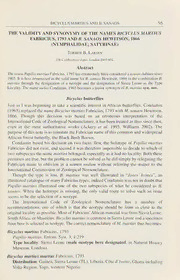
The validity and synonymy of the names Bicyclus martius fabricius, 1793 and B. sanaos Hewitson, 1866 (Nymphalidae; Satyrinae) PDF
Preview The validity and synonymy of the names Bicyclus martius fabricius, 1793 and B. sanaos Hewitson, 1866 (Nymphalidae; Satyrinae)
BICYCLUS MARTIUS AND B. SANAOS 95 THE VALIDITY AND SYNONYMY OF THE NAMES BICYCLUS MARTIUS FABRICIUS, 1793 AND B. SANAOS HEWITSON, 1866 (NYMPHALIDAE; SATYRINAE) Torben B. Larsen 358 Coldharbour Lane, London SW9 8PL. Abstract The taxon Papilio martins Fabricius, 1793 has erroneously been considered anomen dubium since 1965. It is here resurrected as the valid name for B. sanaos Hewitson, 1866 in the combination B. martins through the designation of a neotype and the designation of Sierra Leone as the Type Locality. The name melas Condamin, 1965 becomes ajunior synonym of B. martins syn. nov. Bicyclus butterflies Just as I was beginning to take a scientific interest in African butterflies, Condamin (1965) replaced the name Bicyclus martins Fabricius, 1793 with M. sanaos Hewitson, 1866. Though this decision was based on an erroneous interpretation of the International Code ofZoological Nomenclature, it has been treated as thus since then, even in the most authoritative works (Ackery et al. 1995, Williams 2002). The purpose of this note is to reinstate the Fabrician name of this common and widespread African forest butterfly, the Black Bush Brown. Condamin based his decision on two facts: first, the holotype of Papilio martins Fabricius did not exist, and second it was therefore impossible to decide to which of two subspecies the name martins belonged, especially as it had no locality. Both these premises are true, but the problem cannot be solved as he did simply by relegating the Fabrician name to oblivion as a nomen nudum without referring the matter to the International Commission of Zoological Nomenclature. Though the type is lost, B. martius was well illustrated in “Jones’ leones", an illustrated catalogue of many Fabricius types; indeed Condamin was not in doubt that Papilio martius illustrated one of the two subspecies of what he considered as B. sanaos. When the holotype is missing, the only valid route to solve such an issue seems to be the selection of a neotype. The International Code of Zoological Nomenclature has a number of recommendations, one of which is that the neotype should be from as close to the original locality as possible. Most ofFabricius' African material was from Sierra Leone, South Africa, or Mauritius. Bicyclus martius is common in Sierra Leone and a specimen from here is selected as neotype. The correct nomenclature ofM. martius thus becomes: Bicyclus martius Fabricius, 1793 Papilio martius, Entom. Syst. 3, 1:219 Type locality: Sierra Leone (male neotype here designated, in Natural History Museum, London). Bicyclus martius martius Fabricius, 793 1 Distribution: Guinea, Sierra Leone (TL), Liberia, Cote d'Ivoire, Ghana including Volta Region, Togo, western Nigeria. 96 ENTOMOLOGISTS RECORD, VOL. 115 25.iii.2003 Bicyclus martins sanaos Hewitson, 866 1 Mycalesis sanaos Exotic butterflies, 111:94 , Type locality: Nigeria, Old Calabar (male holotype in Natural History Museum, London) = Bicyclus sanaos melas Condamin, 1965 syn. nov. Bull. I.F.A.N., XXVII: 1439- 1448. Type locality: Cote d'Ivoire, Abidjan Distribution: eastern Nigeria (Cross River loop) to most ofthe equatorial forest zone. The differences between the two subspecies are mainly these: The male of ssp. martins has the inner androconial hair pencil beige; it is black in ssp. sanaos. The female of ssp. martius is uniformly dark brown above; in ssp. sanaos there is a prominent white subapical band. Specimens between the Niger and the Cross River loop in eastern Nigeria may be somewhat intermediate. References Ackery, R R., Smith, C. R. & Vane-Wright, R. I., 1995. Carcasson's African Butterflies. CS1RO Australia. Condamin, M., 1965. Mises au point de synonymie et descriptions de nouveaux Bicyclus (Lepidoptera Satyridae). Bulletin de /’/MV XXVII, Ser. A: 1439-1448. Williams, M. C., 2002. Butterflies andskippers oftheAfrotropical Region. CD-ROM. South Africa. SUBSCRIBER NOTICE Request for British examples of allegedly Japanese species During the late 18th century, Carl Peter Thunberg stayed in Japan and published two booklets, Fauna Japonica and Fauna Japonica Continuata in which over a hundred , insect species were reported from Japan. One ofthe problems I have is that most species described by those earlier scientists are in fact not actually found in Japan. I am, therefore, looking for examples of these non-Japanese species in an attempt to establish what species Thunberg had really observed during his stay in Japan. The list of desiderata is as follows: Coleoptera: Paederus riparius, Staphylinus erythropterus, Potosia aeruginosa, Blister unicolor, Epuraea aestiva, Ptinusfur, Buprestis rustica, Palorus depressus, Corticeus bicolor, Corticeus fraxini, Exochomus quadripustulatus, Mordella aculeata, Phyllotreta nemorum, Lochmaea capreae, Cassida nobilis. Lepidoptera: Sphinx atropos, Antitype chi, Elophila nymphaeata, Eulithis prunata, Scopula immutata, Tortrix viridana. Diptera: Sarcophaga carnaria, Psila fimetaria, Seioptera vibrans, Sepsis cynipsea, Haematopota pluvialis, Melanostoma mellinum, Psychola phalaenoides. Hymenoptera: Ancistrocerus parietum, Liris niger, Sirex cyaneus. Odonata: Calopteryx virgo, Coenagrion puella. Orthopteroidea: Macroscytus brunneus, Blatta orientalis, Gryllotalpa gryllotalpa. If you have specimens of these insects and are able to provide to me one or two examples of each, I will be most grateful - Hideo Ogai, Nariki-build. No. 301, 2-7- 27, Tabata, Kita-ku, Tokyo, 1 14-0014 JAPAN.
